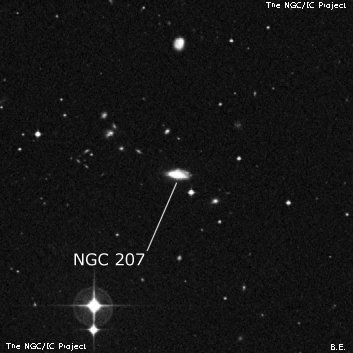
J.L.E. Dreyer discovered NGC 207 on 29 Oct 1877 as the observer on Lord Rosse's 72". He wrote, "About 35 seconds preceding and 25' ± south [of NGC 210] is [NGC 178], very faint, S, lE p f, mbMN, stellar, 5' nnf a coarse double star 10-11 and 12m. A very insignificant object." The description applies, as well as the time difference (actual value 32 seconds preceding) in RA although the galaxy is 5' NNW of the coarse double star instead of NNE as stated.
Dreyer assumed R.J. Mitchell's description from 7 Dec 1857 referred to NGC 207, but as it mentions the object is elongated N-S, it more likely applies to[NGC 178. Ormond Stone independently discovered NGC 207 at Leader-McCormick Observatory on 3 Nov 1885 and reported it as new (LM 1-9) in the observatory's first discovery list.
IC 41 (discovered by Javelle) lies 3.7' north, although MCG, PGC and HyperLeda incorrectly equate IC 41 with NGC 207 (error also in Megastar). RNGC misclassified NGC 207 as nonexistent and it was reported as not found at Helwan observatory in 1924 (though. MCG -03-02-035 was noted 4' S of IC 41). See RNGC Corrections #5.
400/500mm - 17.5" (11/6/93): faint, small, elongated 3:2 E-W, 25"x15". A mag 14.3 star is just 40" SW of center. Located 4.4' NW of mag 9.2 SAO 147389. Forms a pair with NGC 178 9' WNW. Member of the NGC 210 group.
600/800mm - 24" (9/30/16): at 282x; fairly faint/moderately bright, fairly small, elongated 5:3 E-W, 25"x15". A mag 14 star is close southwest [separation 38"]. NGC 178 is 8.7' NW and IC 41 is 3.8' N. A mag 9.5 star lies 4.4' SE.
Notes by Steve Gottlieb